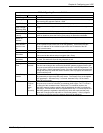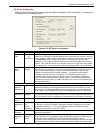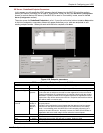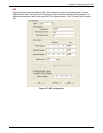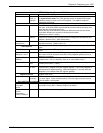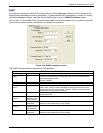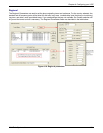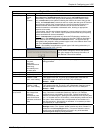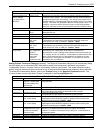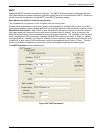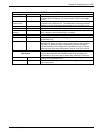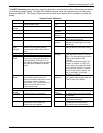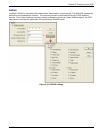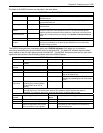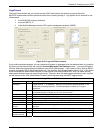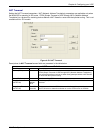
Chapter 4: Configuring your VOIP
Multi-Tech Systems, Inc. 64
“Regional Parameter” Definitions (continued)
Field Name
V
alues Description
Country Selection for
Built-In Modem
(not applicable to
MVP210)
country name MultiVOIP units operating with the X.06 software release (and above)
include a built-in modem. The administrator can dial into this modem to
configure the MultiVOIP unit remotely. The country name values in this
field set telephony parameters that allow the modem to work in the listed
country. This value may be different than the Country/Region value. For
example, a user may need to choose “Europe” as the Country/Region
value but “Denmark” as the Country-Selection-for-Built-In-Modem value.
User Defined Tones fields
Type column
alphanumeric
name
Name of supervisory tone pair. Cannot be same as name of any
standard tone pair.
Frequency 1 Freq. in Hertz Lower frequency of pair.
Frequency 2 Freq. in Hertz Higher frequency of pair.
Gain 1 +3dB to –31dB
and “mute”
setting
Amplification factor of lower frequency of pair.
This applies to any supervisory tones that the MultiVOIP outputs as
audio to the FXS, FXS, or E&M port. Default: “Mute”
Gain 2 +3dB to –31dB
and “mute”
setting
Amplification factor of higher frequency of pair.
This applies to any supervisory tones that the MultiVOIP outputs as
audio to the FXS, FXO, or E&M port. Default: “Mute”
Cadence
(ms) On/Off
n/n/n/n
four integer time
values in
milliseconds;
(zero value
indicates
continuous tone)
On/off pattern of tone durations used to denote supervisory tones
specified by user. Supervisory tones relate to answering and
disconnection of calls. Although most cadences have only two parts (an
“on” duration and an “off” duration), some telephony cadences have four
parts. Most cadences, then, are expressed as two iterations of a two-
part sequence. Although this is redundant, it is necessary to allow for
expression of 4-part cadences.
Setting Custom Tones and Cadences (optional). The Regional Parameters dialog box has a secondary dialog
box that allows you to customize DTMF tone pairs to create unique ring-tones, dial-tones, busy-tones or
“unobtainable” tones or “re-order” tones or “survivability” tones for your system. This screen allows the user to
specify tone-pair attributes that are not found in any of the standard national/regional telephony toning schemes.
To access this customization feature, click on the Custom button on the Regional Parameters screen. The
“Custom” button is active only when “Custom” is selected in the Country/Region field.
Custom Tone-Pair Settings Definitions
Field Name
V
alues Description
Tone Pair dial tone, busy tone
ring tone, ‘unobtainable’
tone, survivability tone,
re-order tone
Identifies the type of telephony signaling tone for which frequencies are
being specified.
Tone Pair Values
A
bout Defaults: US telephony values are used as defaults on this screen.
Frequency 1 Frequency in Hertz Frequency of lower tone of pair.
This outbound tone pair enters the MultiVOIP at the input port.
Frequency 2 Frequency in Hertz Frequency of higher tone of pair.
This outbound tone pair enters the MultiVOIP at the input port.
Gain 1 +3dB to –31dB
and “mute” setting
Amplification factor of lower frequency of pair. This figure describes
amplification that the MultiVOIP applies to outbound tones entering the
MultiVOIP at the input port. Default: -16dB
Gain 2 +3dB to –31dB
and “mute” setting
Amplification factor of higher frequency of pair. This figure describes
amplification that the MultiVOIP applies to outbound tones entering the
MultiVOIP at the input port. Default: -16dB
Cadence 1 integer time value in
milliseconds; zero value
for dial-tone indicates
continuous tone
On/off pattern of tone durations used to denote phone ringing, phone busy,
dial tone (“0” indicates continuous tone) survivability and re-order.
Cadence 1 is duration of first period of tone being “on” in the cadence of
the telephony signal.
Cadence 2 duration in milliseconds Cadence 2 is duration of first “off” period in signaling cadence.
Cadence 3 duration in milliseconds Cadence 3 is duration of second “on” period in signaling cadence.
Cadence 4 duration in milliseconds Cadence 4 is duration of second “off” period in the signaling cadence.



